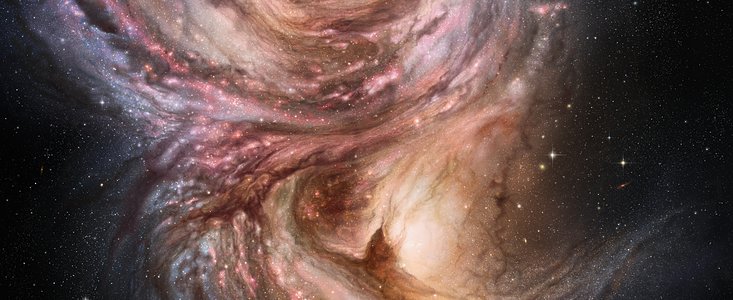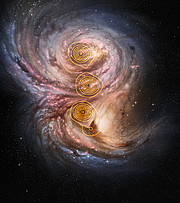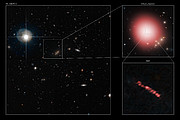Press Release
APEX Snaps First Close-up of Star Factories in Distant Universe
21 March 2010
For the first time, astronomers have made direct measurements of the size and brightness of regions of star-birth in a very distant galaxy, thanks to a chance discovery with the APEX telescope. The galaxy is so distant, and its light has taken so long to reach us, that we see it as it was 10 billion years ago. A cosmic “gravitational lens” is magnifying the galaxy, giving us a close-up view that would otherwise be impossible. This lucky break reveals a hectic and vigorous star-forming life for galaxies in the early Universe, with stellar nurseries forming one hundred times faster than in more recent galaxies. The research is published online today in the journal Nature.
Astronomers were observing a massive galaxy cluster [1] with the Atacama Pathfinder Experiment (APEX) telescope, using submillimetre wavelengths of light, when they found a new and uniquely bright galaxy, more distant than the cluster and the brightest very distant galaxy ever seen at submillimetre wavelengths. It is so bright because the cosmic dust grains in the galaxy are glowing after being heated by starlight. The new galaxy has been given the name SMM J2135-0102.
“We were stunned to find a surprisingly bright object that wasn’t at the expected position. We soon realised it was a previously unknown and more distant galaxy being magnified by the closer galaxy cluster,” says Carlos De Breuck from ESO, a member of the team. De Breuck was making the observations at the APEX telescope on the plateau of Chajnantor at an altitude of 5000 m in the Chilean Andes.
The new galaxy SMM J2135-0102 is so bright because of the massive galaxy cluster that lies in the foreground. The vast mass of this cluster bends the light of the more distant galaxy, acting as a gravitational lens [2]. As with a telescope, it magnifies and brightens our view of the distant galaxy. Thanks to a fortuitous alignment between the cluster and the distant galaxy, the latter is strongly magnified by a factor of 32.
“The magnification reveals the galaxy in unprecedented detail, even though it is so distant that its light has taken about 10 billion years to reach us,” explains Mark Swinbank from Durham University, lead author of the paper reporting the discovery. “In follow-up observations with the Submillimeter Array telescope, we’ve been able to study the clouds where stars are forming in the galaxy with great precision.”
The magnification means that the star-forming clouds can be picked out in the galaxy, down to a scale of only a few hundred light-years — almost down to the size of giant clouds in our own Milky Way. To see this level of detail without the help of the gravitational lens would need future telescopes such as ALMA (the Atacama Large Millimeter/submillimeter Array), which is currently under construction on the same plateau as APEX. This lucky discovery has therefore given astronomers a unique preview of the science that will be possible in a few years time.
These “star factories” are similar in size to those in the Milky Way, but one hundred times more luminous, suggesting that star formation in the early life of these galaxies is a much more vigorous process than typically found in galaxies that lie nearer to us in time and space. In many ways, the clouds look more similar to the densest cores of star-forming clouds in the nearby Universe.
“We estimate that SMM J2135-0102 is producing stars at a rate that is equivalent to about 250 Suns per year,” says de Breuck. “The star formation in its large dust clouds is unlike that in the nearby Universe, but our observations also suggest that we should be able to use similar underlying physics from the densest stellar nurseries in nearby galaxies to understand star birth in these more distant galaxies.”
Notes
[1] Galaxy clusters are among the most massive objects in the Universe kept together by gravity. They are composed of hundreds to thousands of galaxies, which make up to only about a tenth of their total mass. The bulk of their mass, which amounts to up to a million billion [1015] times the mass of our Sun, is composed of hot gas and dark matter. In this case, the cluster being observed has the designation MACS J2135-010217 (or MACS J213512.10-010258.5), and is at a distance of about four billion light-years.
[2] Gravitational lensing is an effect forecast by Albert Einstein’s theory of general relativity. Due to their gigantic mass and their intermediate position between us and very distant galaxies, galaxy clusters act as extremely efficient gravitational lenses, bending the light coming from background galaxies. Depending on the cluster mass distribution a host of interesting effects are produced, such as magnification, shape distortions, giant arcs, and multiple images of the same source.
More information
This research was presented in a paper, “Intense star formation within resolved compact regions in a galaxy at z=2.3” (A. M. Swinbank et al., DOI 10.1038/nature08880) to appear online in Nature today.
The team is composed of A. M. Swinbank, I. Smail, J. Richard, A. C. Edge, and K. E. K. Coppin (Institute for Computational Cosmology, Durham University, UK), S. Longmore, R. Blundell, M. Gurwell, and D. Wilner (Harvard-Smithsonian Center For Astrophysics, USA), A. I. Harris and L. J. Hainline (Department of Astronomy, University of Maryland, USA), A.J. Baker (Department of Physics and Astronomy, Rutgers, University of New Jersey, USA), C. De Breuck, A. Lundgren and G. Siringo (ESO), R. J. Ivison (UKATC and Royal Observatory of Edinburgh, UK), P. Cox, M. Krips and R. Neri (Institut de Radio Astronomie Millimétrique, France), B. Siana (California Institute of Technology, USA), D. P. Stark (Institute of Astronomy, University of Cambridge, UK), and J. D. Younger (Institute for Advanced Study, USA).
The Atacama Pathfinder Experiment (APEX) telescope is a 12-metre telescope, located at 5100 m altitude on the arid plateau of Chajnantor in the Chilean Andes. APEX operates at millimetre and submillimetre wavelengths. This wavelength range is a relatively unexplored frontier in astronomy, requiring advanced detectors and an extremely high and dry observatory site, such as Chajnantor. APEX, the largest submillimetre-wave telescope operating in the southern hemisphere, is a collaboration between the Max Planck Institute for Radio Astronomy, the Onsala Space Observatory and ESO. Operation of APEX at Chajnantor is entrusted to ESO. APEX is a “pathfinder” for ALMA — it is based on a prototype antenna constructed for the ALMA project, it is located on the same plateau and will find many targets that ALMA will be able to study in extreme detail.
ESO, the European Southern Observatory, is the foremost intergovernmental astronomy organisation in Europe and the world’s most productive astronomical observatory. It is supported by 14 countries: Austria, Belgium, Czechia, Denmark, France, Finland, Germany, Italy, the Netherlands, Portugal, Spain, Sweden, Switzerland and the United Kingdom. ESO carries out an ambitious programme focused on the design, construction and operation of powerful ground-based observing facilities enabling astronomers to make important scientific discoveries. ESO also plays a leading role in promoting and organising cooperation in astronomical research. ESO operates three unique world-class observing sites in Chile: La Silla, Paranal and Chajnantor. At Paranal, ESO operates the Very Large Telescope, the world’s most advanced visible-light astronomical observatory and VISTA, the world’s largest survey telescope. ESO is the European partner of a revolutionary astronomical telescope ALMA, the largest astronomical project in existence. ESO is currently planning a 42-metre European Extremely Large optical/near-infrared Telescope, the E-ELT, which will become “the world’s biggest eye on the sky”.
Links
Contacts
Mark Swinbank
Durham University
Durham, United Kingdom
Tel: +44 191 334 3786
Email: a.m.swinbank@durham.ac.uk
Carlos de Breuck
ESO
Garching, Germany
Tel: +49 89 3200 6613 (until 23 March available on +1 626 272 8473, time zone PDT, USA)
Email: cdebreuc@eso.org
Douglas Pierce-Price
ESO
Garching, Germany
Tel: +49 89 3200 6759
Email: dpiercep@eso.org
About the Release
| Release No.: | eso1012 |
| Name: | SMM J2135-0102 |
| Type: | Early Universe : Galaxy |
| Facility: | Atacama Pathfinder Experiment |
| Instruments: | LABOCA, SABOCA |
| Science data: | 2010Natur.464..733S |






